2021 HYUNDAI ELANTRA HYBRID engine oil
[x] Cancel search: engine oilPage 12 of 555
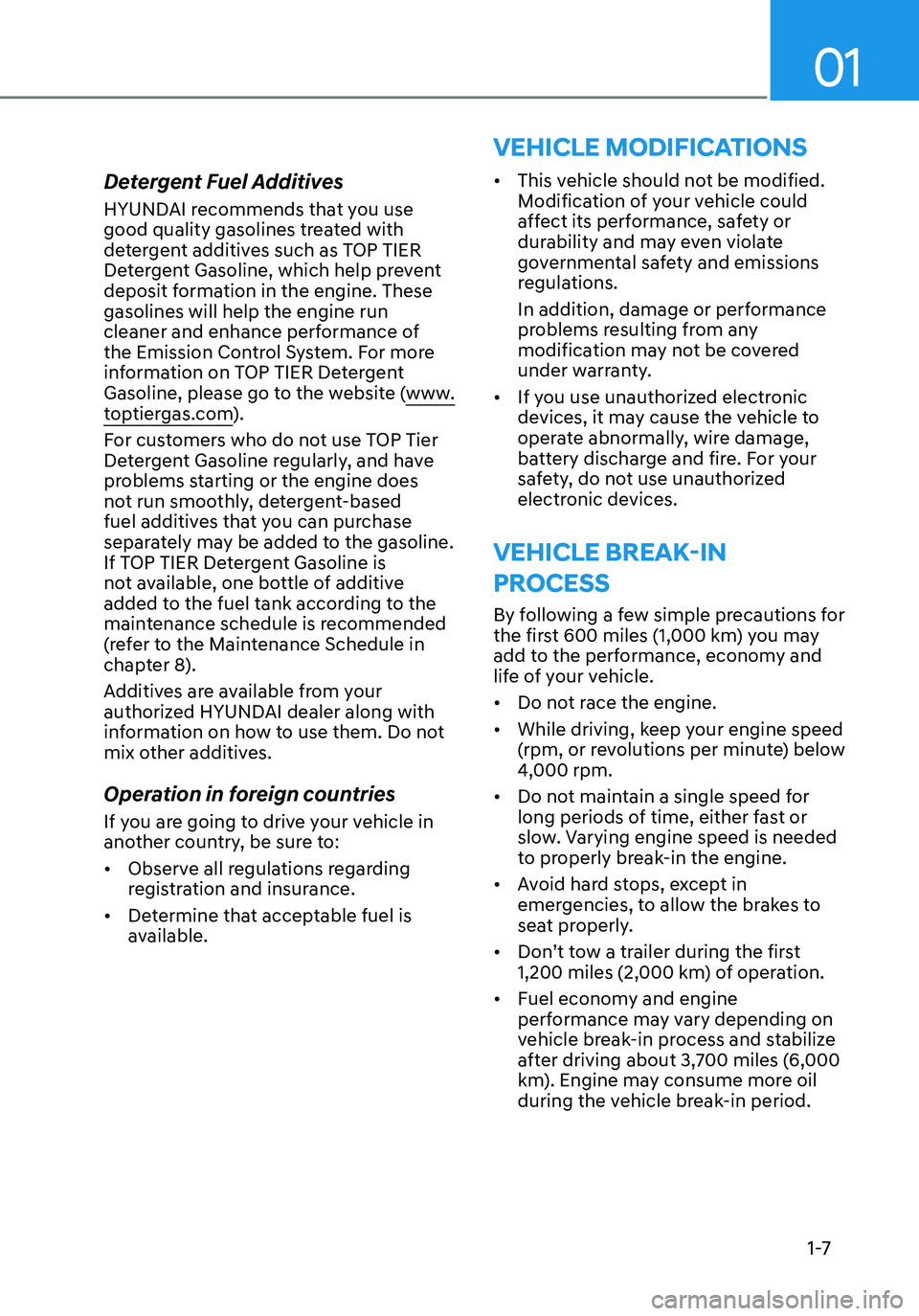
01
1 -7
Detergent Fuel Additives
HYUNDAI recommends that you use
good quality gasolines treated with
detergent additives such as TOP TIER
Detergent Gasoline, which help prevent
deposit formation in the engine. These
gasolines will help the engine run
cleaner and enhance performance of
the Emission Control System. For more
information on TOP TIER Detergent
Gasoline, please go to the website (www.
toptiergas.com ).
For customers who do not use TOP Tier
Detergent Gasoline regularly, and have
problems starting or the engine does
not run smoothly, detergent-based
fuel additives that you can purchase
separately may be added to the gasoline.
If TOP TIER Detergent Gasoline is
not available, one bottle of additive
added to the fuel tank according to the
maintenance schedule is recommended
(refer to the Maintenance Schedule in
chapter 8).
Additives are available from your
authorized HYUNDAI dealer along with
information on how to use them. Do not
mix other additives.
Operation in foreign countries
If you are going to drive your vehicle in
another country, be sure to:
• Observe all regulations regarding
registration and insurance.
• Determine that acceptable fuel is
available. •
This vehicle should not be modified.
Modification of your vehicle could
affect its performance, safety or
durability and may even violate
governmental safety and emissions
regulations.
In addition, damage or performance
problems resulting from any
modification may not be covered
under warranty.
• If you use unauthorized electronic
devices, it may cause the vehicle to
operate abnormally, wire damage,
battery discharge and fire. For your
safety, do not use unauthorized
electronic devices.
VEHICLE BREAK-IN
PROCESS
By following a few simple precautions for
the first 600 miles (1,000 km) you may
add to the performance, economy and
life of your vehicle.
• Do not race the engine.
• While driving, keep your engine speed
(rpm, or revolutions per minute) below
4,000 rpm.
• Do not maintain a single speed for
long periods of time, either fast or
slow. Varying engine speed is needed
to properly break-in the engine.
• Avoid hard stops, except in
emergencies, to allow the brakes to
seat properly.
• Don’t tow a trailer during the first
1,200 miles (2,000 km) of operation.
• Fuel economy and engine
performance may vary depending on
vehicle break-in process and stabilize
after driving about 3,700 miles (6,000
km). Engine may consume more oil
during the vehicle break-in period.
VEHICLE MODIFICATIONS
Page 13 of 555
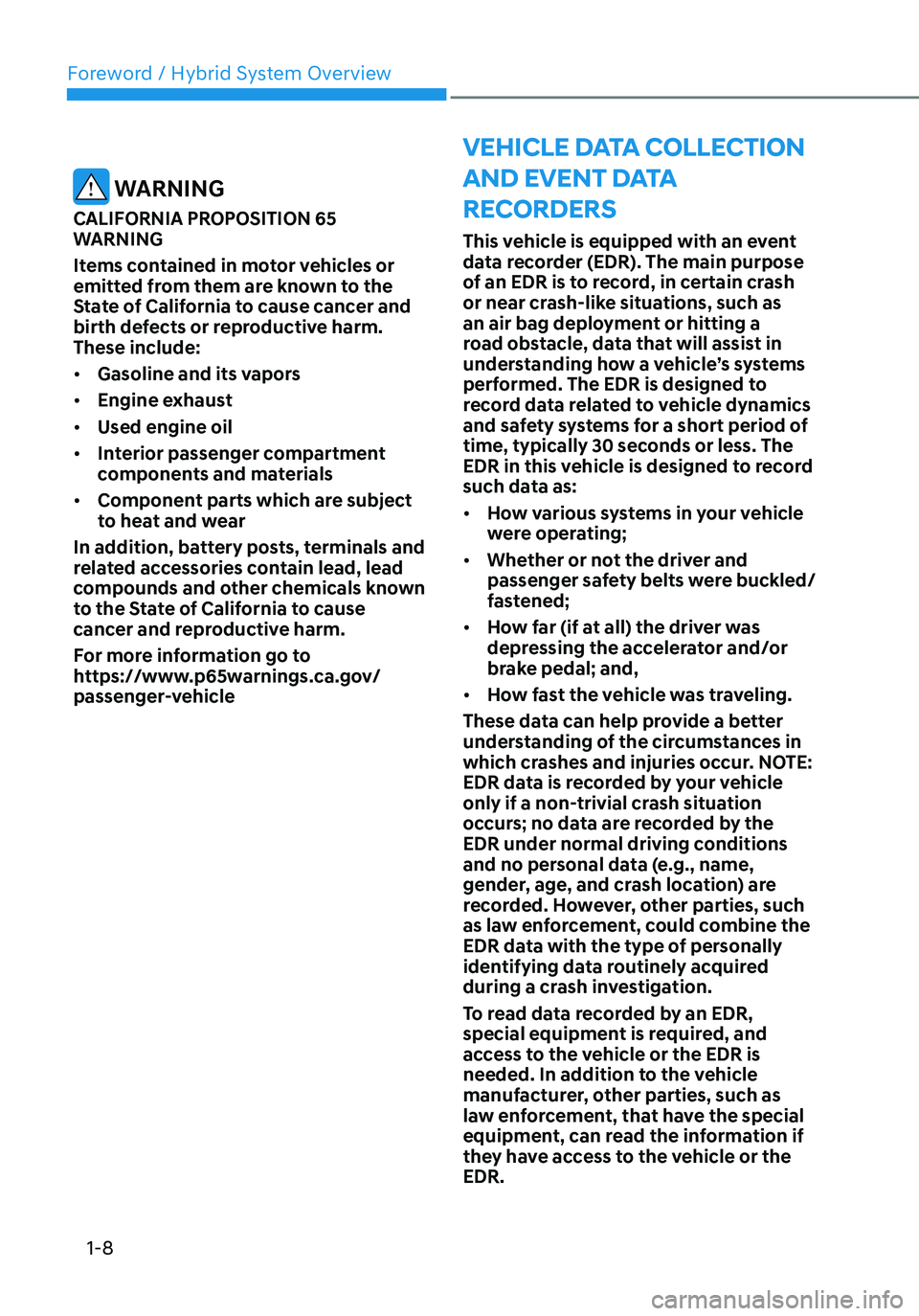
Foreword / Hybrid System Overview
1-8
VEHICLE DATA COLLECTION
AND EVENT DATA
RECORDERS
This vehicle is equipped with an event
data recorder (EDR). The main purpose
of an EDR is to record, in certain crash
or near crash-like situations, such as
an air bag deployment or hitting a
road obstacle, data that will assist in
understanding how a vehicle’s systems
performed. The EDR is designed to
record data related to vehicle dynamics
and safety systems for a short period of
time, typically 30 seconds or less. The
EDR in this vehicle is designed to record
such data as:
• How various systems in your vehicle
were operating;
• Whether or not the driver and
passenger safety belts were buckled/
fastened;
• How far (if at all) the driver was
depressing the accelerator and/or
brake pedal; and,
• How fast the vehicle was traveling.
These data can help provide a better
understanding of the circumstances in
which crashes and injuries occur. NOTE:
EDR data is recorded by your vehicle
only if a non-trivial crash situation
occurs; no data are recorded by the
EDR under normal driving conditions
and no personal data (e.g., name,
gender, age, and crash location) are
recorded. However, other parties, such
as law enforcement, could combine the
EDR data with the type of personally
identifying data routinely acquired
during a crash investigation.
To read data recorded by an EDR,
special equipment is required, and
access to the vehicle or the EDR is
needed. In addition to the vehicle
manufacturer, other parties, such as
law enforcement, that have the special
equipment, can read the information if
they have access to the vehicle or the
EDR.
WARNING
CALIFORNIA PROPOSITION 65
WARNING
Items contained in motor vehicles or
emitted from them are known to the
State of California to cause cancer and
birth defects or reproductive harm.
These include:
• Gasoline and its vapors
• Engine exhaust
• Used engine oil
• Interior passenger compartment
components and materials
• Component parts which are subject
to heat and wear
In addition, battery posts, terminals and
related accessories contain lead, lead
compounds and other chemicals known
to the State of California to cause
cancer and reproductive harm.
For more information go to
https://www.p65warnings.ca.gov/
passenger-vehicle
Page 35 of 555
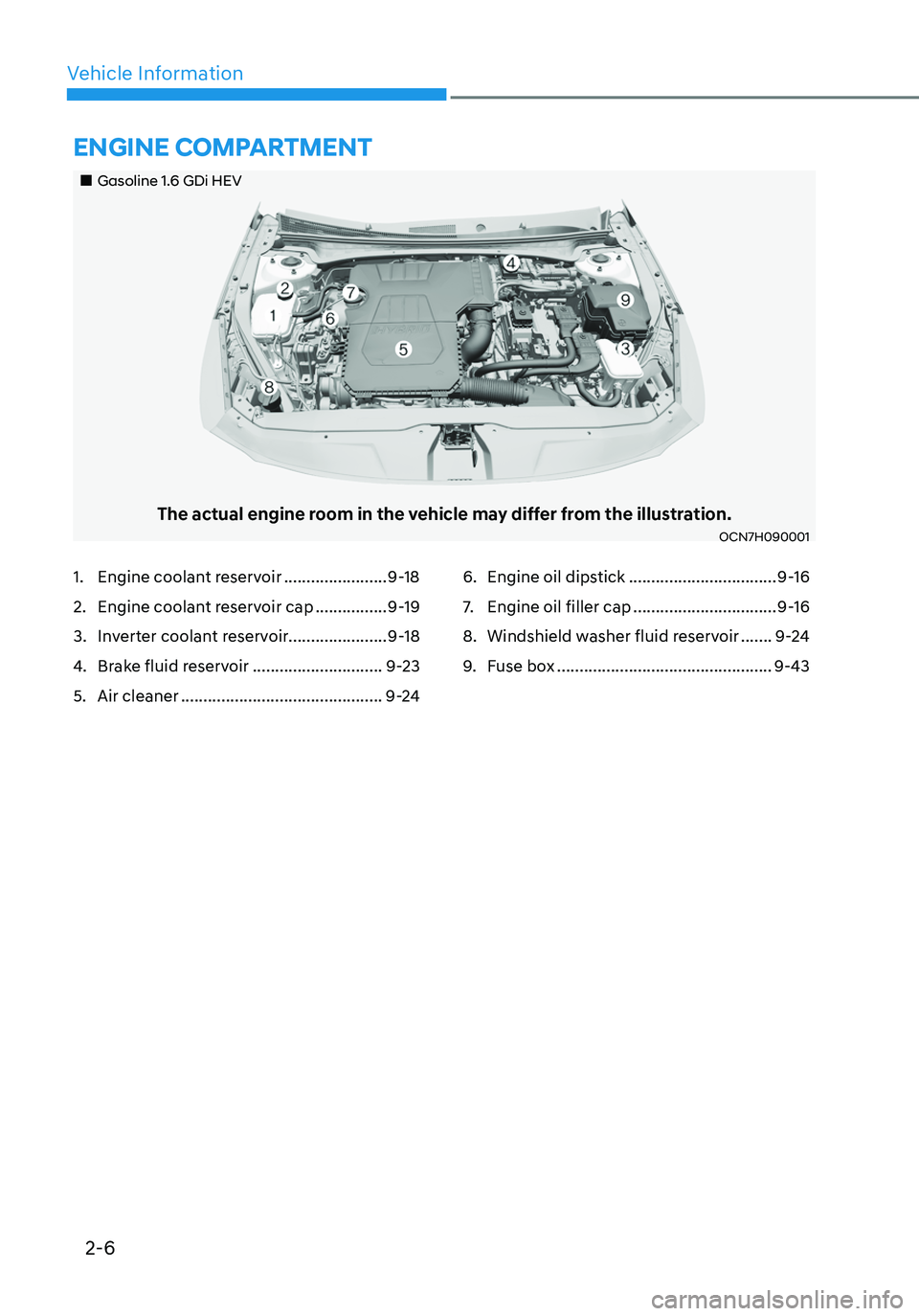
2-6
Vehicle Information
„„Gasoline 1.6 GDi HEV
The actual engine room in the vehicle may differ from the illustration.OCN7H090001
ENGINE COMPARTMENT
1. Engine coolant reservoir .......................9-18
2. Engine coolant reservoir cap ................9-19
3. Inverter coolant reservoir......................9-18
4. Brake fluid reservoir .............................9-23
5. Air cleaner .............................................9-24
6. Engine oil dipstick .................................9-16
7. Engine oil filler cap ................................9-16
8. Windshield washer fluid reservoir .......9-24
9. Fuse box ................................................9-43
Page 40 of 555
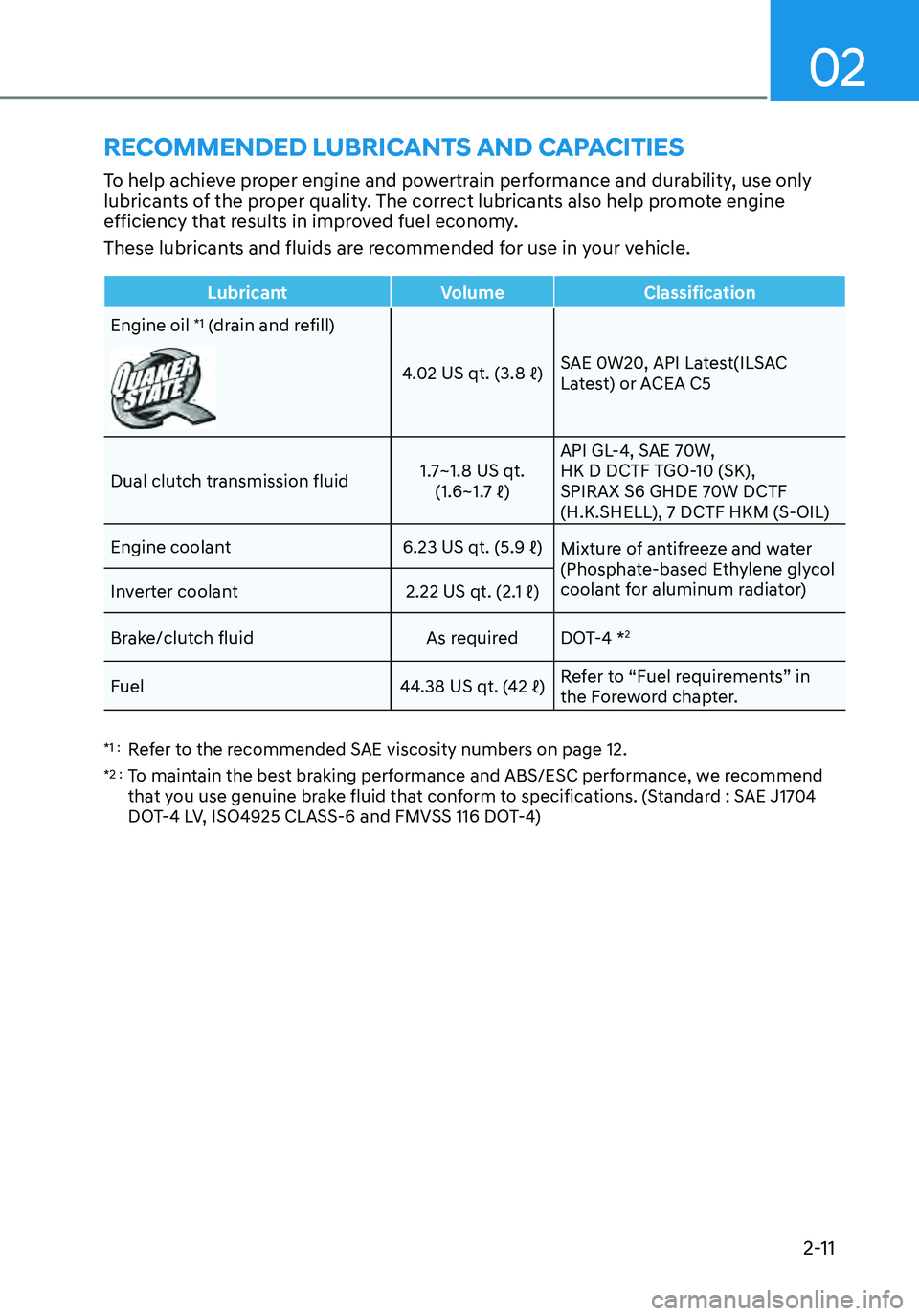
02
2-11
RECOMMENDED LUBRICANTS AND CAPACITIES
To help achieve proper engine and powertrain performance and durability, use only
lubricants of the proper quality. The correct lubricants also help promote engine
efficiency that results in improved fuel economy.
These lubricants and fluids are recommended for use in your vehicle.
LubricantVolumeClassification
Engine oil
*1 (drain and refill)
4.02 US qt. (3.8 ℓ)SAE 0W20, API Latest(ILSAC
Latest) or ACEA C5
Dual clutch transmission fluid1.7~1.8 US qt.(1.6~1.7 ℓ)
API GL-4, SAE 70W,
HK D DCTF TGO-10 (SK),
SPIRAX S6 GHDE 70W DCTF
(H.K.SHELL), 7 DCTF HKM (S-OIL)
Engine coolant
6.23 US qt. (5.9 ℓ)Mixture of antifreeze and water
(Phosphate-based Ethylene glycol
coolant for aluminum radiator)
Inverter coolant
2.22 US qt. (2.1 ℓ)
Brake/clutch fluid As required DOT-4 *2
Fuel
44.38 US qt. (42 ℓ)Refer to “Fuel requirements” in
the Foreword chapter.
*1 : Refer to the recommended SAE viscosity numbers on page 12.
*2 : To maintain the best braking performance and ABS/ESC performance, we recommend
that you use genuine brake fluid that conform to specifications. (Standard : SAE J1704
DOT-4 LV, ISO4925 CLASS-6 and FMVSS 116 DOT-4)
Page 41 of 555
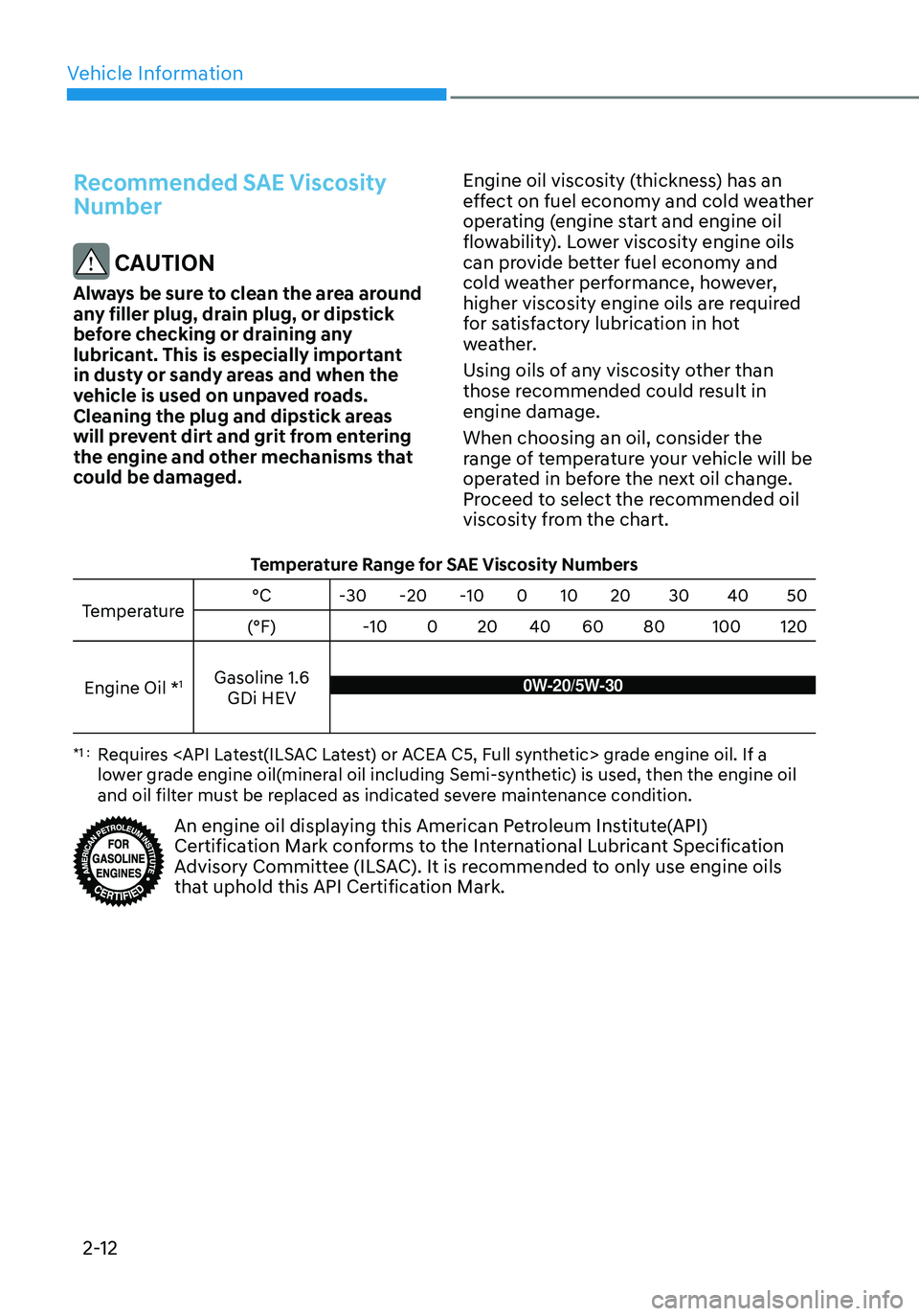
Vehicle Information
2-12
Recommended SAE Viscosity
Number
CAUTION
Always be sure to clean the area around
any filler plug, drain plug, or dipstick
before checking or draining any
lubricant. This is especially important
in dusty or sandy areas and when the
vehicle is used on unpaved roads.
Cleaning the plug and dipstick areas
will prevent dirt and grit from entering
the engine and other mechanisms that
could be damaged.Engine oil viscosity (thickness) has an
effect on fuel economy and cold weather
operating (engine start and engine oil
flowability). Lower viscosity engine oils
can provide better fuel economy and
cold weather performance, however,
higher viscosity engine oils are required
for satisfactory lubrication in hot
weather.
Using oils of any viscosity other than
those recommended could result in
engine damage.
When choosing an oil, consider the
range of temperature your vehicle will be
operated in before the next oil change.
Proceed to select the recommended oil
viscosity from the chart.
Temperature Range for SAE Viscosity Numbers
Temperature °C
-30 -20 -10 0 10 20 30 40 50
(°F) -10 0 20 40 60 80 100 120
Engine Oil *
1Gasoline 1.6 GDi HEV0W-20/5W-30
*1 : Requires
lower grade engine oil(mineral oil including Semi-synthetic) is used, then the engine oil
and oil filter must be replaced as indicated severe maintenance condition.
An engine oil displaying this American Petroleum Institute(API)
Certification Mark conforms to the International Lubricant Specification
Advisory Committee (ILSAC). It is recommended to only use engine oils
that uphold this API Certification Mark.
Page 102 of 555

Instrument Cluster
4
Instrument Cluster ........................................................................\
.................4-4Instrument Cluster Control ........................................................................\
..............4-5
Adjusting instrument cluster illumination ............................................................4-5
Gauges and Meters ........................................................................\
..........................4-5
Speedometer ........................................................................\
.................................4-5
Power gauge ........................................................................\
.................................4-6
Hybrid battery SOC (State of Charge) gauge ......................................................4-6
Fuel gauge ........................................................................\
......................................4 -7
Outside temperature gauge ........................................................................\
..........4-8
Odometer ........................................................................\
.......................................4-8
Range ........................................................................\
..............................................4-9
Transmission shift indicator ........................................................................\
.............4-9
Dual clutch transmission shift indicator ..............................................................4-9
Warning and Indicator Lights ........................................................................\
........4-10
Ready indicator ........................................................................\
............................4-10
EV mode indicator ........................................................................\
.......................4-10
Service warning light ........................................................................\
...................4-10
Air Bag Warning Light ........................................................................\
..................4-10
Seat Belt Warning Light ........................................................................\
................4-11
Parking Brake & Brake Fluid Warning Light .........................................................4-11
Regenerative brake warning light ........................................................................\
4-11
Anti-lock Brake System (ABS) Warning Light ......................................................4-12
Electronic Brake Force Distribution (EBD) System Warning Light ....................4-12
Electronic Parking Brake (EPB) Warning Light ....................................................4-12
AUTO HOLD Indicator Light (if equipped) ..........................................................4-13
Electric Power Steering (EPS) Warning Light ......................................................4-13
Malfunction Indicator Lamp (MIL) .......................................................................4-13
Charging System Warning Light ........................................................................\
..4-14
Engine Oil Pressure Warning Light ......................................................................4-14
Low Fuel Level Warning Light ........................................................................\
......4-14
Master Warning Light ........................................................................\
...................4-15
Low Tire Pressure Warning Light ........................................................................\
.4-15
Electronic Stability Control (ESC) Indicator Light ..............................................4-15
Electronic Stability Control (ESC) OFF Indicator Light .......................................4-16
AUTO STOP indicator light ........................................................................\
...........4-16
Immobilizer Indicator Light ........................................................................\
..........4-16
Immobilizer Indicator Light (with smart key) .....................................................4-17
Turn Signal Indicator Light ........................................................................\
...........4-17
Exterior Light Warning Light ........................................................................\
........4-17
LED headlight warning light ........................................................................\
.........4-18
High Beam Indicator Light ........................................................................\
...........4-18
Light ON Indicator Light ........................................................................\
...............4-18
4.Instrument Cluster
Page 114 of 555
![HYUNDAI ELANTRA HYBRID 2021 Owners Manual 04
4-13
AUTO HOLD Indicator Light
(if equipped)
This indicator light illuminates:
• [White] When you activate the auto
hold system by pressing the AUTO
HOLD button.
• [Green] When you stop the HYUNDAI ELANTRA HYBRID 2021 Owners Manual 04
4-13
AUTO HOLD Indicator Light
(if equipped)
This indicator light illuminates:
• [White] When you activate the auto
hold system by pressing the AUTO
HOLD button.
• [Green] When you stop the](/manual-img/35/56094/w960_56094-113.png)
04
4-13
AUTO HOLD Indicator Light
(if equipped)
This indicator light illuminates:
• [White] When you activate the auto
hold system by pressing the AUTO
HOLD button.
• [Green] When you stop the vehicle
completely by depressing the brake
pedal with the auto hold system
activated.
• [Yellow] When there is a malfunction
with the auto hold system.
In this case, have the vehicle
inspected by an authorized HYUNDAI
dealer.
For more information, refer to “Auto
Hold” in chapter 6.
Electric Power Steering (EPS)
Warning Light
This warning light illuminates:
• When you place the ignition switch to
the ON position.
-The Electric Power Steering Warning
light illuminates for about 3 seconds
and then goes off.
• Whenever there is a malfunction with
the EPS.
If this occurs, have the vehicle
inspected by an authorized HYUNDAI
dealer.
Malfunction Indicator Lamp
(MIL)
This warning light illuminates:
• When you place the ignition switch to
the ON position.
-The malfunction indicator light
illuminates for about 3 seconds and
then goes off.
• Whenever there is a malfunction with
either the emission control system or
the engine or the vehicle powertrain.
If this occurs, have the vehicle
inspected by an authorized HYUNDAI
dealer.
NOTICE
Driving with the Malfunction Indicator
Lamp (MIL) on may cause damage to
the emission control system which
could affect drivability and/or fuel
economy.
NOTICE
If the Malfunction Indicator Lamp
(MIL) illuminates, potential catalytic
converter damage is possible which
could result in loss of engine power.
In this case, have the vehicle inspected
by an authorized HYUNDAI dealer as
soon as possible.
If the oil pressure lowers due to
insufficient engine oil, etc., the engine
oil pressure warning light turns on
and an enhanced engine protection
system that limits the engine’s power
is activated. After that, engine warning
light turns on if driving repeatedly and
continuously.
Page 115 of 555

Instrument Cluster
4-14
Charging System Warning
Light
When this warning light illuminates while
the engine is running, the battery is not
being charged. Immediately turn OFF
all electrical accessories. Try not to use
electrically operated controls, such as
the power windows. Keep the engine
running.
Have the vehicle inspected by an
authorized HYUNDAI dealer as soon as
possible.
Engine Oil Pressure Warning
Light
This warning light illuminates:
When the engine oil pressure is low.
If the engine oil pressure is low:
1. Drive carefully to the nearest safe
location and stop your vehicle.
2. Turn the engine off and check
the engine oil level (For more
information, refer to "Engine Oil" in
chapter 8). If the level is low, add oil
as required.
If the warning light remains on after
adding oil or if oil is not available, have
the vehicle inspected by an authorized
HYUNDAI dealer as soon as possible.
WARNING
When oil pressure is restored to an
optimal level, the oil pressure warning
light and the protection system that
limits engine power will turn off. Even
if the oil pressure returns to normal,
check the engine once again in a safe
place.
NOTICE
• If the engine is not turned OFF
immediately after the Engine
Oil Pressure Warning Light is
illuminated, severe damage could
occur.
• If the warning light stays on while the
engine is running, it indicates that
there may be serious engine damage
or malfunction. In this case:
1. Stop the vehicle as soon as it is
safe to do so.
2. Turn off the engine and check the
oil level. If the oil level is low, fill
the engine oil to the proper level.
3. Start the engine again. If the
warning light stays on after the
engine has started, turn the
engine off immediately. In this
case, have the vehicle inspected
by an authorized HYUNDAI dealer.
Low Fuel Level Warning Light
This warning light illuminates:
When the fuel tank is nearly empty. Add
fuel as soon as possible.
NOTICE
Driving with the Low Fuel Level warning
light on or with the fuel level below "E"
can cause the engine to misfire and
damage the catalytic converter.